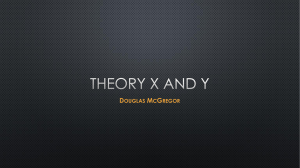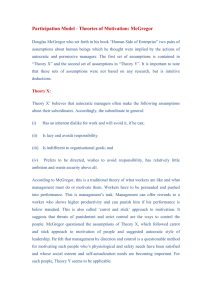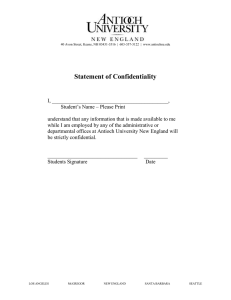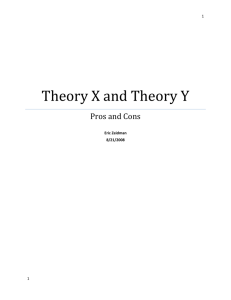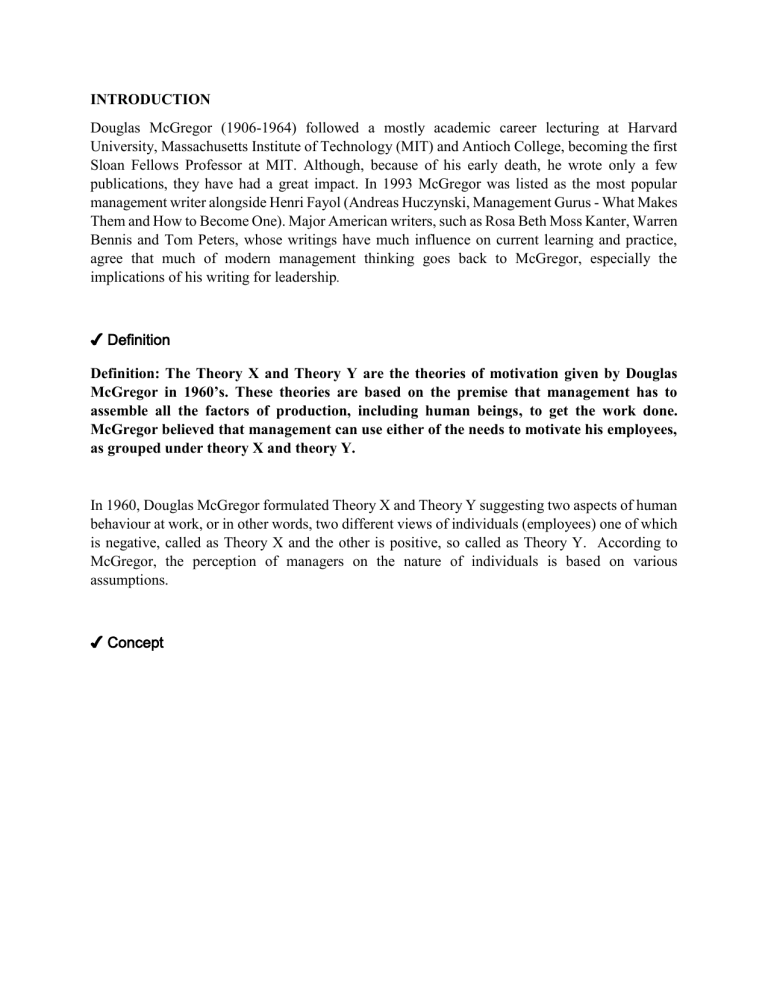
INTRODUCTION Douglas McGregor (1906-1964) followed a mostly academic career lecturing at Harvard University, Massachusetts Institute of Technology (MIT) and Antioch College, becoming the first Sloan Fellows Professor at MIT. Although, because of his early death, he wrote only a few publications, they have had a great impact. In 1993 McGregor was listed as the most popular management writer alongside Henri Fayol (Andreas Huczynski, Management Gurus - What Makes Them and How to Become One). Major American writers, such as Rosa Beth Moss Kanter, Warren Bennis and Tom Peters, whose writings have much influence on current learning and practice, agree that much of modern management thinking goes back to McGregor, especially the implications of his writing for leadership. ✔ Definition Definition: The Theory X and Theory Y are the theories of motivation given by Douglas McGregor in 1960’s. These theories are based on the premise that management has to assemble all the factors of production, including human beings, to get the work done. McGregor believed that management can use either of the needs to motivate his employees, as grouped under theory X and theory Y. In 1960, Douglas McGregor formulated Theory X and Theory Y suggesting two aspects of human behaviour at work, or in other words, two different views of individuals (employees) one of which is negative, called as Theory X and the other is positive, so called as Theory Y. According to McGregor, the perception of managers on the nature of individuals is based on various assumptions. ✔ Concept ✔ Content & principles ● Theory X states that employees dislike and try to avoid work, so they must be coerced into doing it. Most workers do not want responsibilities, lack ambition, and value job security more than anything else. McGregor personally held that the more optimistic theory, Y, was more valid. ● Theory Y where people are self-motivated and enjoy the challenge of work. Managers with this assumption have a more collaborative relationship with their people, and motivate them by allowing them to work on their own initiative, giving them responsibility, and empowering them to make decisions. ✔ Explanation & Examples Theory X: the traditional view of direction and control Theory X is based on the assumptions that: 1. The average human being has an inherent dislike of work and will avoid it if possible. 2. Because of this human dislike of work, most people must be coerced, controlled, directed, and threatened with punishment to get them to put forth adequate effort toward the achievement of organizational objectives. 3. The average human being prefers to be directed, wishes to avoid responsibility, has relatively little ambition, and wants security above all. A Theory X management style therefore requires close, firm supervision with clearly specified tasks and the threat of punishment or the promise of greater pay as motivating factors. A manager working under these assumptions will employ autocratic controls which can lead to mistrust and resentment from those they manage. McGregor acknowledges that the `carrot and stick' approach can have a place, but will not work when the needs of people are predominantly social and egoistic. Ultimately, the assumption that a manager’s objective is to persuade people to be docile, to do what they are told in exchange for reward or escape from punishment, is presented as flawed and in need of re-evaluation. Theory Y: the integration of individual and organizational goals Theory Y is based on the assumptions that: 1. The expenditure of physical and mental effort in work is as natural as play or rest. The average human being does not inherently dislike work. Depending upon controllable conditions, work may be a source of satisfaction, or a source of punishment. 2. External control and the threat of punishment are not the only means for bringing about effort toward organizational objectives. People will exercise self-direction and self-control in the service of objectives to which they are committed. 3. Commitment to objectives is a function of the rewards associated with their achievement. The most significant of such rewards, e.g., the satisfaction of ego and self-actualization needs, can be direct products of effort directed towards organizational objectives. 4. The average human being learns, under proper conditions, not only to accept but to seek responsibility. Avoidance of responsibility, lack of ambition, and emphasis on security are generally consequences of experience, not inherent human characteristics. 5. The capacity to exercise a relatively high degree of imagination, ingenuity, and creativity in the solution of organizational problems is widely, not narrowly, distributed in the population. 6. Under the conditions of modern industrial life, the intellectual potentialities of the average human being are only partially utilized. Theory Y assumptions can lead to more cooperative relationships between managers and workers. A Theory Y management style seeks to establish a working environment in which the personal needs and objectives of individuals can relate to, and harmonies with, the objectives of the organization. In The Human Side of Enterprise McGregor recognized that Theory Y was not a panacea for all ills. By highlighting Theory Y, he hoped instead to persuade managers to abandon the limiting assumptions of Theory X and consider using the techniques suggested by Theory Y. ✔ Evolutions & progress McGregor’s Theory X and Theory Y • McGregor urged managers to shift their view of human nature away from a set of assumptions he called ‘Theory X’ and towards ones he called ‘Theory Y’. • Managers holding Theory X assumptions • approach their jobs believing that those who work for them generally dislike work, lack ambition, are irresponsible, are resistant to change and prefer to be led rather than to lead. • Theory Y assumptions - people are willing to work, are capable of self-control, are willing to accept responsibility, are imaginative and creative, and are capable of self-direction. ✔ Limitations & challenges Challenges and Limitations of Theory X and Theory Y: McGregor’s interpretations characterized his subjective explanation on the world around him. They were not the consequences of investigation or research. They have been applied to decisionmaking practices rather than to further the conclusions of research work. The major distinct disadvantage of Theory X and Theory Y is that they are put forward as challenging sets of assumptions — a supervisor is either motivated by Theory X or by Theory Y. However, modern revisions including “contingency theorists” argue that Theory Y is not essentially a progressive alternative to a dull Theory X. Both sets of assumptions may be effective, depending on the environments of the circumstances. However, the main conclusion that McGregor pulls from his effort is that Theory Y is a much more accurate depiction of human behavior, and for that reason Theory Y management approaches should be implemented. ✔ Includes conclusion Though these theories are very basic in nature, they provide a platform for future generations of management theories and practitioners to understand the changing dynamics of human behavior. McGregor’s X-Y Theories remain guiding principle to the management to evolve processes which help in organizational development. SUMMARY McGregor believed that managers' basic beliefs have a dominant influence on the way that organizations are run. Managers' assumptions about the behavior of people are central to this. McGregor argued that these assumptions fall into two broad categories - Theory X and Theory Y. These findings were detailed in The Human Side of Enterprise, first published in 1960. Theory X and Theory Y describe two views of people at work and may be used to describe two opposing management styles.
